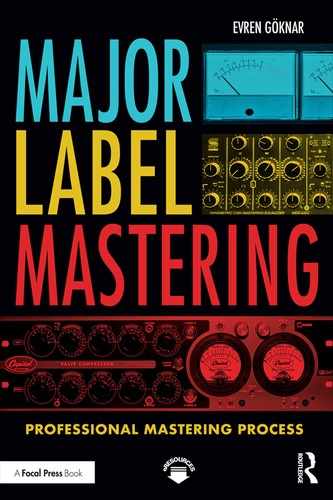Book Description
Major Label Mastering: Professional Mastering Process distills 25 years of mastering experience at Capitol Records into practical understandings and reliable systems. Containing unparalleled insights, this book reveals the mastering tricks and techniques used by Evren Göknar at one of the world’s most notable record labels.
Beginning with the requisite competencies every Mastering Engineer must develop, Major Label Mastering delves into the particulars of the mastering studio, as well as fundamental mastering tools. Included among these tools is The Five Step Mastering Process, a rigorously tested system that equips the practitioner to successfully and confidently master a project to exacting standards of audio fidelity. Covering all bases, the book discusses both macro and micro considerations: from mindset approach and connecting with clients down to detailed guidelines for processing audio, advanced methods, and audio restoration. Each chapter ends with exercises intended to deepen understanding and skill, or to supplement course study.
Suitable for all levels, this is a unique resource for students, artists, and recording and Mastering Engineers alike. Major Label Mastering is supplemented by digital resources including audio examples and video tutorials.
Table of Contents
- Cover
- Half Title
- Title
- Copyright
- Dedication
- Contents
- Preface
- Acknowledgments
- Credits/Gratitude/Disclaimer
- Introduction
- Part I • The Key Competencies and Understandings of a Mastering Engineer
- Chapter 1 The Mastering Engineer
- Competencies
- Become an Audiophile
- Become a Critical Listener
- Become Aware of Recording Methods and Technologies
- Become Knowledgeable About Audio Mastering Tools
- Become Knowledgeable About Acoustics and Listening Environments
- Become Proficient With Digital Audio Workstations (DAWs)
- Become Adept at Quality Control (QC) Methods
- Become Able to Generate the Audio Master
- Implement Recallable Workflow Approaches
- Become Personable and Entrepreneurial in Demeanor
- Key Understandings to Possess
- Conclusion
- Exercises
- Competencies
- Chapter 2 Listening Experience: The Mastering Engineer’s Primary Concern
- Chapter 1 The Mastering Engineer
- Part II • The Mastering Studio and Fundamental Mastering Tools
- Chapter 3 The Mastering Studio
- A Critical Listening Environment
- The Anatomy of a Professional Mastering Studio
- Conclusion
- Exercises
- Chapter 4 Fundamental Mastering Tools and The Primary Colors of Mastering
- Chapter 3 The Mastering Studio
- Part III • Professional Mastering Process: The Five Step Mastering Process
- Chapter 5 Step I: Objective Assessment
- Chapter 6 Step II: Subjective Assessment
- Chapter 7 Step III: The Mastering Game Plan
- Setup—The Mastering Game Plan ‘Flight Check’
- After You, Kind Sir: Compressor or Equalizer First in the Mastering Chain?
- Monitoring Positions in Signal Path
- Oscillator Sweep the Signal Path
- Verify L/R Integrity Through Mastering System
- Execution of The Mastering Game Plan
- Gain Distribution in The Three Zone Mastering System
- Conclusion
- Exercises
- Chapter 8 Step IV: Assembly—Links in a Chain
- Chapter 9 Step V: Delivery—Generate the Master
- Part IV • Professional Mastering Process—Macro Considerations
- Part V • Professional Mastering Process—Micro Considerations
- Chapter 13 Detailed Guidelines for Processing Audio
- Chapter 14 Advanced Mastering Chain Tools and Techniques
- Side-Chain Compression (s.c.)
- Multiband Compression/Limiting (MBC/L)
- Serial Peak-Limiting
- Dynamic EQ
- Saturation
- Analog Tape Compression
- Clipping
- Parallel Processing (Compression and EQ)
- Mid-Side Processing (M/S)
- Hybrid Domain Mastering (Both Digital and Analog)
- Line Amps and Transformers
- Stem Mastering
- Intercuts (Mastering Moves by Song Section)
- Adding Reverberation
- Conclusion
- Exercises
- Chapter 15 Mid-Side (M/S): An Elixir of Mastering Hope
- M/S at Capitol Mastering
- M/S Stereo Recording Technique—History and Origins
- In a Mastering Context
- Encoding From Stereo Into M/S
- Decoding Out of M/S Back Into Stereo
- Creating an M/S Matrix in Pro Tools
- Encoding (DAW Example)
- Decoding (DAW Example)
- Practical Applications of M/S in Mastering
- M/S Hardware Processors for Mastering
- M/S Plug-Ins for Mastering
- Conclusion
- Exercises
- Chapter 16 In-the-Box Considerations
- Chapter 17 De-Noising/Audio Restoration (Out, Damned Spot!)
- Chapter 18 Conclusion and Summary
- Appendix I: Common Mastering Acronyms and Terms
- Appendix II: Awards and Notable Projects
- Appendix III: Mastering Biography
- Index
